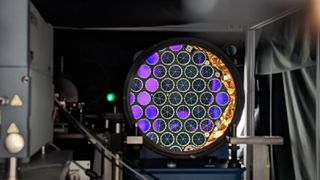
iew of the reflection of a Laser Retroreflector Array through a testing apparatus at the Goddard Space Flight Center in Greenbelt, Md. Laser retroreflector arrays make it possible to do laser ranging – using small bursts of laser light to detect distances between objects.
(Image credit: NASA)
The U.S. Space Force aims to better pinpoint the location of Earth’s true center using lasers on GPS satellites slated to launch in 2025.
A set of laser retroreflector arrays, or LRAs, will be installed onto two GPS III satellites, called SV9 and SV10, as part of NASA’s Space Geodesy Program space sensor network. The lasers are designed to make precise sub-centimeter level measurements using a technique called Satellite Laser Ranging (SLR), which will allow researchers to more accurately determine Earth’s center, according to a statement from the Space Force.
On May 6, the two LRAs were delivered to Lockheed Martin to be integrated with the GPS III satellites ahead of launch. The mission is a partnership between the Space Force, the National Geospatial-Intelligence Agency (NGA) and NASA.
“We were able to add new capabilities to the GPS constellation years ahead of schedule while ensuring the billions of people who rely on our signals daily would be unaffected,” U.S. Space Force Col. Andrew Menschner, Position, Navigation and Timing Delta (Provisional) commander at Space Operations Command, said in the statement. “We expect LRAs to be standard on future GPS vehicles and are pleased that SV9 and SV10 will have the capability prior to launch.”
Laser ranging relies on small bursts of laser light to detect distances between objects. Pulses of laser light from a ground station are directed toward an orbiting satellite equipped with the LRAs, which then reflect the light beams back to the original source. Therefore, the time it takes for the laser light to travel from the ground to the satellite and back again can be used to calculate the distance between the satellite and the ground.
The light is reflected using three mirrors positioned at right angles, forming an inside corner of a cube. The LRAs consist of an array of 48 of the mirrored corner cubes, ensuring that the beam of light is reflected back out at the same angle it came in at.
The LRAs were built by NASA and the Naval Research Laboratory’s Naval Center for Space Technology, and will be operated by the U.S. Space Force, according to the statement.
Breaking space news, the latest updates on rocket launches, skywatching events and more!
Related: US Space Force is launching more missions than ever. Lawmakers worry America’s spaceports can’t keep up
Having accurate positioning information is essential to find the center of the mass of Earth, which can undergo small changes following events like tsunamis and earthquakes. Therefore, the data collected by the LRAs will allow researchers to more accurately measure how the world is changing.
“GPS III putting two new reflectors on orbit next year shows how quickly we are able to upgrade capabilities,” Menschner said in the statement. “This success is an incredible tribute to the outstanding talent, mission focus and partnering across the entire team.”
Join our Space Forums to keep talking space on the latest missions, night sky and more! And if you have a news tip, correction or comment, let us know at: [email protected].
Samantha Mathewson joined Space.com as an intern in the summer of 2016. She received a B.A. in Journalism and Environmental Science at the University of New Haven, in Connecticut. Previously, her work has been published in Nature World News. When not writing or reading about science, Samantha enjoys traveling to new places and taking photos! You can follow her on Twitter @Sam_Ashley13.
>>> Read full article>>>
Copyright for syndicated content belongs to the linked Source : Space.com – https://www.space.com/space-force-lasers-pinpoint-earth-center































